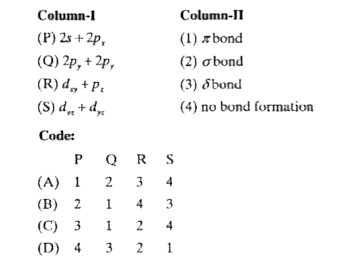Find the imposible overlapping if z-axis is considered to be intermolecular axis :
s+px
pz+dz2
s+pz
dx2−y2+dz2
The correct Answer is:A, D
Step by step video, text & image solution for Find the imposible overlapping if z-axis is considered to be intermolecular axis : by Chemistry experts to help you in doubts & scoring excellent marks in Class 12 exams.
Topper's Solved these Questions
- BOOK - GRB PUBLICATIONCHAPTER - CHEMICAL BONDING-IEXERCISE - Comperhension Type-11videos
CHEMICAL BONDING-I
- BOOK - GRB PUBLICATIONCHAPTER - CHEMICAL BONDING-IEXERCISE - Comperhension Type45videos
CHEMICAL BONDING-I
- BOOK - GRB PUBLICATIONCHAPTER - CHEMICAL BONDING-IEXERCISE - Reasoning Type42videos
CHEMICAL BONDING-I
- BOOK - GRB PUBLICATIONCHAPTER - CARBOXYLIC ACID AND DERIVATIVES, AMINES AND OTHER NITROGEN COMPOUNDSEXERCISE - Subjective type19videos
CARBOXYLIC ACID AND DERIVATIVES, AMINES AND OTHER NITROGEN COMPOUNDS
- BOOK - GRB PUBLICATIONCHAPTER - CHEMICAL KINETICSEXERCISE - Subjective Type63videos
CHEMICAL KINETICS
Similar Questions
Knowledge Check
- Question 1 - Select One
The end to end overlaping of bonding orbitals along the intermolecular axis is known as
Asigma bondingBπ bondingCback bondingDnone of the above - Question 2 - Select One
Which of the following representation represent π∗ molecular orbital , (z is considered as internuclear axis)
A B
B C
C D
D
- Question 3 - Select One
Which of the following overlaps is incorrect? (Assuming z-axis to be the internuclear axis)
A2py+2py right arrow π2pyB2pz+2pz rightarrow σ2pzC2px+2px→π2pxD1s+2py→π(1s−2py)
When the atomic orbitals overlap in such a way that their axis remain parallel to each other and perpendicular to the intermolecular axis this type of overlapping results the formation of
View SolutionWhich of the following combination is not allowed in the LCAO method for the formation of molecular orbital (consider Z-axis as the molecular axis) ? .
View SolutionWhich of the following overlaps of atomic orbitals does not form π-bond if z-axis is the internuclear axis?
View SolutionWhich of the following overlaps gives a σ bond with x as internuclear axis?
View SolutionWhich of the following will result in zero overlap if molecular axis is x−axis ?
View Solution


